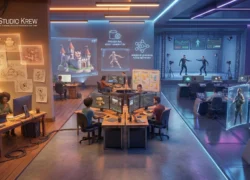As a leading company in mobile game development, StudioKrew is excited to share our expertise in hyper casual mobile game development. This field is not only reshaping the gaming landscape but also driving unprecedented business growth. Did you know that hypercasual games accounted for a staggering 50% of all mobile game downloads in 2023? Moreover, top titles in this genre have been known to generate millions in monthly revenue, showcasing the immense potential of hyper casual game development as a lucrative business endeavour. This comprehensive guide’ll delve into the intricacies of creating hypercasual games, from conceptualization to launch, providing you with the insights and strategies needed to thrive in this dynamic industry and about Mobile game development services.
Hypercasual games epitomize simplicity and engagement, offering instant playability and broad appeal to players worldwide. With their addictive yet easy-to-grasp mechanics, these games are perfect for quick gaming sessions, catering to the on-the-go lifestyle of modern gamers. Here at StudioKrew, we specialize in crafting captivating hypercasual gaming experiences, and we’re excited to share our expertise with you. Remember, the beauty of hypercasual games lies in their accessibility and simplicity, making them a perfect starting point for your game development journey.
This blog post is designed to be a practical guide for every essential step of hyper casual game development. It empowers you to plan effectively, design engaging mechanics, and execute successful launch strategies. Whether you’re an aspiring developer or an established studio, this guide will equip you with the knowledge and actionable steps necessary to thrive in the hypercasual gaming market.
Join us on this exhilarating journey as we uncover the secrets of hypercasual mobile game development services. By following our guide, you’ll gain a profound understanding of what it takes to create a standout game that resonates with players and drives success in a competitive industry. And remember, with StudioKrew by your side, you’re partnering with a top game development studio committed to excellence and innovation. Let’s embark on this exciting adventure together!
Understanding Hypercasual Game Development
Hypercasual games are characterized by their minimalistic design, straightforward gameplay, and accessibility to a broad audience. Unlike traditional mobile games that may feature complex narratives or advanced mechanics, hypercasual games prioritize simplicity and immediate gratification. These games often involve basic tasks such as tapping, swiping, or dragging objects on the screen, making them easy to pick up and play for users of all ages and gaming backgrounds.
One of the critical defining features of hypercasual games is their addictive nature. Despite their simplistic mechanics, hypercasual games excel at keeping players engaged for extended periods. This is achieved through clever game design techniques such as rewarding progression, competitive leaderboards, and strategic use of in-game challenges and rewards.
Furthermore, hypercasual games are designed for short play sessions, ideally suited for the on-the-go lifestyle of modern gamers. Whether waiting in line, commuting, or taking a quick break, players can enjoy a quick gaming fix without the need for a significant time investment. This accessibility has contributed to the widespread popularity of hypercasual games across diverse demographics.
Exploring Genres in Hyper Casual Games
While hypercasual games share common characteristics, they can be further categorized into several genres, each offering a unique gameplay experience. Here are some of the most popular hypercasual genres:
Endless Runners
Endless runner games challenge players to navigate a continuously scrolling environment while dodging obstacles, collecting power-ups, and aiming for high scores. Players typically control a character that automatically runs forward, and they must swipe or tap to jump, slide, or perform other actions to avoid obstacles. Examples: Subway Surfers, Temple Run, Alto’s Adventure
Puzzle Games
Puzzle games in the hypercasual genre present players with a series of challenges that require logic, spatial awareness, and problem-solving skills to solve. Players may need to match colors, connect shapes, or clear blocks from the screen within a limited number of moves or time. Examples: 2048, Flow Free, Candy Crush Saga

Idle Clickers
Idle clicker games, or incremental games, task players with generating resources or currency by simply tapping or clicking on the screen. As players accumulate resources, they can invest in upgrades and automation to increase their resource production and progress further in the game. Examples: Cookie Clicker, Idle Miner Tycoon, Adventure Capitalist
Physics-Based Games
Physics-based games challenge players to manipulate objects and interact with the game environment to achieve specific goals. These games often rely on realistic physics simulations to create engaging and unpredictable gameplay experiences, requiring players to plan their actions to solve puzzles or complete levels carefully. Examples: Angry Birds, Cut the Rope, Where’s My Water?
Arcade Classics
Arcade classics encompass a wide range of retro-inspired games that evoke nostalgia for the golden age of arcade gaming. These games often feature simple controls, fast-paced action, and high-score challenges, appealing to players seeking nostalgia and competitive gameplay. Examples: Brick Breaker, Pac-Man, Space Invaders
Match-3 Games
Match-3 games task players with swapping adjacent tiles or objects to create matches of three or more identical items. Players must strategically plan their moves to clear as many tiles as possible within a limited number of moves or time, often to achieve high scores or complete objectives. Examples: Bejeweled, Candy Crush Saga, Homescapes
Word Games
Word games task players to form words from a set of letters or solve puzzles based on word associations or clues. Players must use their vocabulary and linguistic skills to find the correct solutions and progress through the game. Examples: Wordscapes, Word Cookies, Word Connect.

Tower Defense
Tower defense games require players to strategically place defensive towers or units along a path to prevent waves of enemies from reaching a goal. Players must carefully manage resources and upgrade their defenses to withstand increasingly tricky enemy attacks. Examples: Plants vs. Zombies, Kingdom Rush, Bloons TD
Bubble Shooter
Bubble shooter games task players with shooting colored bubbles from the bottom of the screen to match and pop groups of three or more bubbles of the same color. Players must aim carefully and strategically to clear the playing field and prevent the bubbles from reaching the bottom. Examples: Bubble Shooter, Bubble Witch Saga, Panda Pop
Timing and Reaction Games
Timing and reaction games challenge players to react quickly to stimuli or perform actions at precise moments to achieve success. These games often feature simple mechanics such as tapping, swiping, or pressing buttons in rhythm with on-screen cues. Examples: Flappy Bird, Ladder Dash.
Card Games
Card games involve players using a deck of cards to compete against each other or the game itself. These games may include various mechanics such as deck-building, hand management, and strategic card play. Players typically take turns drawing and playing cards to achieve specific objectives or defeat opponents. Examples: Solitaire, Freecel.

BONUS: Unveiling the secret of successful Card Game Development and Launch. Read Now
Two-Player on Single Device Games
Two-player on a single device games allow two players to compete against each other or collaborate on a shared screen using a single device. These games often feature split-screen or turn-based gameplay mechanics, allowing players to take turns interacting with the game and challenging each other to achieve victory. Examples: Challenge Master 2 Player Game, Offline LOL Games.

By understanding the various hypercasual genres, developers can identify unique gameplay mechanics and design elements to create compelling, innovative gaming experiences that resonate with players.
Now that you are aware of the Genres in Hypercasual Games, let’s explore the classification of these games based on the common mechanics used.
Explore Mechanics in Hypercasual Games.
In the dynamic world of hypercasual games, mechanics play a crucial role in shaping the player experience, hypercasual game development, and game success. Hypercasual games prioritize simplicity and intuitive gameplay, unlike traditional games that may feature complex mechanics and intricate systems. This section’ll delve into the key mechanics commonly found in hypercasual games and explore how they contribute to the overall gaming experience.
Tap
Tap mechanics involve players interacting with the game by tapping on the screen. This simple yet effective mechanic is widely used in hyper-casual games for actions such as jumping, shooting, or selecting options. Example: In “Ladder Dash,” players tap the screen to climb the ladder and swipe to change the position of their hands to tackle obstacles.

Timing
Timing mechanics require players to perform actions at precise moments to achieve success. This can include tapping to jump over obstacles, releasing at the right time to launch projectiles, or hitting targets within specific time windows. Example: In “Helix Jump,” players must time their taps to make the ball drop through the gaps in the helix tower and avoid the colored areas.
Stacking
Stacking mechanics involve building structures or objects by stacking components on top of each other. Players must carefully balance and align pieces to create stable structures or achieve specific objectives. For example, the “Stack game in Offline LOL Games” challenges players to stack colorful blocks to build a tower. The blocks must be stacked neatly to avoid losing segments of the tower.

Turning
Turning mechanics require players to rotate objects or navigate obstacles by turning left or right. This could involve rotating platforms, steering vehicles, or controlling characters’ movements through twisting paths. Example: In “Rider,” players control a bike as it speeds along a track filled with obstacles. Tapping the screen causes the bike to flip and rotate, allowing players to navigate through the tight spaces.
Dexterity or Agility
Dexterity or agility mechanics test players’ hand-eye coordination and reflexes by requiring them to react quickly to changing conditions or obstacles. For example, “Knife Hit in Challenge Master” challenges players to throw knives at spinning targets. Players must time their throws carefully to avoid hitting other knives and progress to higher levels.
Tilt
Tilt mechanics utilize device motion sensors to control gameplay elements. Players tilt their devices to steer characters, manipulate objects, or navigate through environments by tilting them in different directions. For example, “Rolling Sky” requires players to tilt their devices to guide a ball through challenging obstacle courses. Tilting left or right controls the direction of the ball’s movement.
Merging
Merging mechanics involve combining similar elements or objects to create larger or more powerful versions. Example: In “2048 game in Offline LOL Game”, players merge identical numbered tiles by sliding them across the board. Merging tiles of the same number creates a new tile with double the value.
Growing
Growing mechanics task players with developing or expanding their character, object, or territory over time. For example: “Snake vs. Block” challenges players to control a snake as it collects balls to grow longer. The snake must navigate through blocks with numbers, and the snake’s length determines how many blocks it can break through.
Swerve
Swerve mechanics require players to navigate through obstacles or enemies by swerving or zigzagging to avoid collisions. Example: “ZigZag” challenges players to guide a ball down a narrow pathway by tapping to change direction. The player must swerve left and right to avoid falling off the edges.
Resizing
Resizing mechanics involves changing the size or scale of objects or characters within the game. For example, In “Hole.io,” players control a hole that grows larger as it consumes objects in the environment. The hole must resize strategically to swallow larger objects and other players.
Direction
Direction mechanics focus on controlling the direction of movement or action within the game. Example: “Color Switch” requires players to guide a ball through obstacles of matching colors while avoiding collisions with obstacles of different colors. Tapping the screen changes the direction of the ball’s movement.
By understanding and leveraging these key mechanics, developers can create hypercasual games that are engaging, addictive and accessible to a wide audience.
Phases in Hypercasual Game Development
Creating a successful hypercasual game involves several well-planned phases, each crucial to the game’s overall success. Being the top casual mobile game development company and with a team of top game developers, we have prepared a comprehensive guide covering everything from the initial concept to post-launch support. Each step requires careful consideration and execution. Let’s delve into the phases of hypercasual game development.
1. Planning Your Hypercasual Game
Understanding the Market
Before diving into development, it’s crucial to understand the hypercasual gaming market. The hypercasual genre has seen explosive growth, with games like “Helix Jump” and “Color Switch” reaching millions of downloads globally. Research popular games, identify trends, and analyze what makes these games successful. Tools like App Annie and Sensor Tower can provide valuable insights into market trends and user preferences. Consider your target audience and what they enjoy in a hypercasual game. The market for hypercasual games is expected to reach $3.7 billion by 2025, highlighting the lucrative potential of this genre.
Defining Your Game Concept
With market research in hand, brainstorm game concepts that are simple yet innovative. A unique twist on a familiar concept is the key to a successful hypercasual game. Ensure your game idea is easy to understand and can be played in short bursts. For instance, “Flappy Bird” combined the simplicity of a tap-to-fly mechanic with challenging obstacle navigation, leading to viral success. Aim for a concept that can be described in one sentence and appeals to a broad audience.
Setting Goals and Objectives
Set clear goals and objectives for your game. Define what success looks like for your project, whether it’s a specific number of downloads, high user retention, or strong monetization. Clear goals will guide your development process and keep you focused. For example, a target might be to reach 1 million downloads within the first month or to achieve a retention rate of 40% on day 7. Having measurable objectives helps track progress and make necessary adjustments.
2. Designing Your Hypercasual Game
Creating Simple yet Engaging Mechanics
The core mechanics of a hypercasual game should be straightforward and intuitive. Focus on creating engaging gameplay loops that keep players coming back for more. Avoid complexity and prioritize fun, addictive gameplay. Simple mechanics like tapping, swiping, or dragging are often the most effective. Games like “Knife Hit” and “Stack” demonstrate how simple mechanics can create deeply engaging experiences.
Designing User-Friendly Interfaces
A clean, user-friendly interface is essential for hypercasual games. Design intuitive controls and ensure the user experience is seamless. Players should be able to start playing without any instructions. Minimalist design, with clear visuals and straightforward navigation, enhances accessibility. Remember, the first few seconds of gameplay are crucial for hooking players.
Prototyping and Feedback
Create prototypes to test your game mechanics and interface. Prototyping tools like Unity and Buildbox can help you quickly iterate on your designs. Gather feedback from testers to identify any issues and make improvements. Early testing is crucial to refine your game and ensure it resonates with your target audience. Engaging in a small focus group can provide insights into player behaviour and preferences.
3. Developing Your Hypercasual Game
Choosing the Right Tools and Technologies
Selecting the right tools and technologies is critical for your game development journey. Popular game engines like Unity or Unreal Engine are excellent choices for hypercasual games. They offer robust support for both 2D and 3D game development, extensive documentation, and vibrant community resources. These engines provide the flexibility and power to create engaging and polished games.
At StudioKrew, we leverage our extensive expertise in these industry-leading tools to bring your game concepts to life. Our team is proficient in Unity 3D and Unreal Engine game development, ensuring your game benefits from the best technical foundations. By partnering with us, you gain access to seasoned developers who understand the nuances of hyper casual game development, from optimizing performance to creating smooth, responsive controls. We focus on delivering a seamless development process, allowing you to transform your innovative ideas into market-ready games efficiently and effectively.
Whether you’re just starting or looking to enhance an existing project, StudioKrew’s comprehensive development services can help you achieve your goals. Our proven track record in hypercasual game development means we can provide valuable insights and strategies to ensure your game’s success in the competitive market. Collaborate with StudioKrew to elevate your game development process and maximize your chances of creating the next big hit in the hypercasual gaming world. Contact Now!
Implementing Core Mechanics
Develop the core mechanics of your game based on your design. Focus on smooth, responsive controls and ensure engaging gameplay. Keep the development process agile, allowing for adjustments based on testing feedback. Implementing a lean development cycle with regular playtesting helps fine-tune the game mechanics.
Optimizing Performance and Usability
Optimize your game for performance and usability. Hypercasual games should run smoothly on a wide range of devices. Pay attention to loading times, frame rates, and overall responsiveness to provide the best player experience. A study shows that 47% of players expect a game to load in less than 2 seconds; hence, performance optimization is critical.
4. Launching Your Hypercasual Game
Preparing for Launch
Prepare for your game’s launch by thoroughly testing it on multiple devices. Fix any bugs and ensure the game is polished. Set up necessary app store accounts and prepare your marketing materials. A well-executed launch strategy can significantly impact your game’s initial success.
Marketing and Promotion Strategies
Develop a marketing strategy to promote your game. Utilize social media, influencer partnerships, and app store optimization (ASO) to reach your target audience. Consider creating a teaser campaign to build anticipation before launch. Leverage platforms like Instagram, TikTok, and YouTube, where short, engaging content can go viral quickly.
Post-Launch Maintenance and Updates
After launch, continue to support your game with regular updates and improvements. Monitor player feedback and address any issues promptly. Regular updates can keep your players engaged and attract new users. Use analytics tools to track player behaviour and preferences, guiding future updates.
5. LiveOps for Hypercasual Games
Continuous Improvement
LiveOps (Live Operations) involves continuously improving and updating your game based on player feedback and data analytics. This includes adding new content, running in-game events, and implementing user-requested features. Games like “Subway Surfers” and “Temple Run” have thrived by consistently providing fresh seasonal content and engaging events.
Engaging the Community
Build and engage a community around your game. Interact with players through social media, forums, and in-game events. Engaged players are likelier to stay loyal to your game and spread the word to others. Community management tools can streamline this process and foster a positive player environment.
If you have an upcoming game project and are looking for a dedicated game development company, or follow the link to learn more about game maintenance and LiveOps.

BONUS: Know All About Games LiveOps. Read Now
By meticulously planning and executing each phase, you can create a hypercasual game that captures players’ attention and sustains their engagement over time. StudioKrew can be your ideal partner in this journey, providing end-to-end services and expertise in every game development phase. Our expert game designers and developers are dedicated to turning your innovative ideas into market-ready successes.
Conclusion
Throughout this comprehensive guide, we’ve explored every facet of the development process, from understanding the market to launching your game and beyond. Armed with insights from our team’s approach to strategic content creation, you now have the knowledge and tools to create a hypercasual game that captivates audiences and achieves success in the competitive mobile gaming landscape.
Remember, success in hyper casual mobile game development requires a combination of innovation, strategic planning, and meticulous execution. By following the phases outlined in this guide – from planning and designing to developing, launching, and engaging with your player community – you’ll be well-equipped to navigate the challenges and opportunities that arise along the way.
At StudioKrew, we understand the intricacies of casual game development services and are passionate about helping our clients bring their game ideas to life. With our end-to-end services and expertise in every phase of game development, we’re here to support you on your journey to creating the next big hit in the hypercasual gaming world. Whether you’re a seasoned developer or just starting, we’re committed to helping you achieve your goals and realize your vision.
So, what are you waiting for? Let’s turn your hyper casual game ideas into reality and make a splash in the mobile gaming market. Get in touch with StudioKrew today, and let’s embark on this exciting adventure together. Here’s to your success with our hypercasual mobile game development services!






